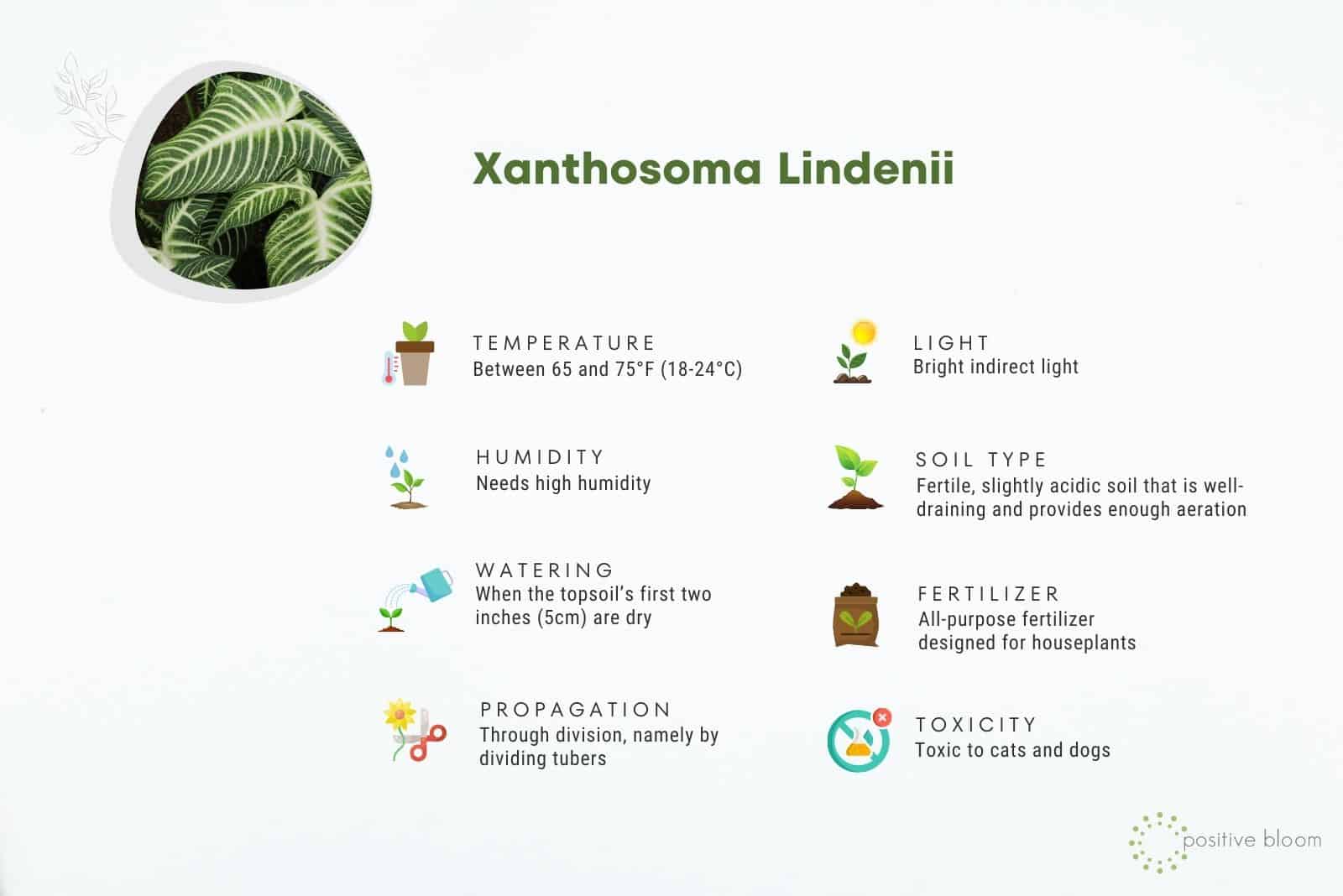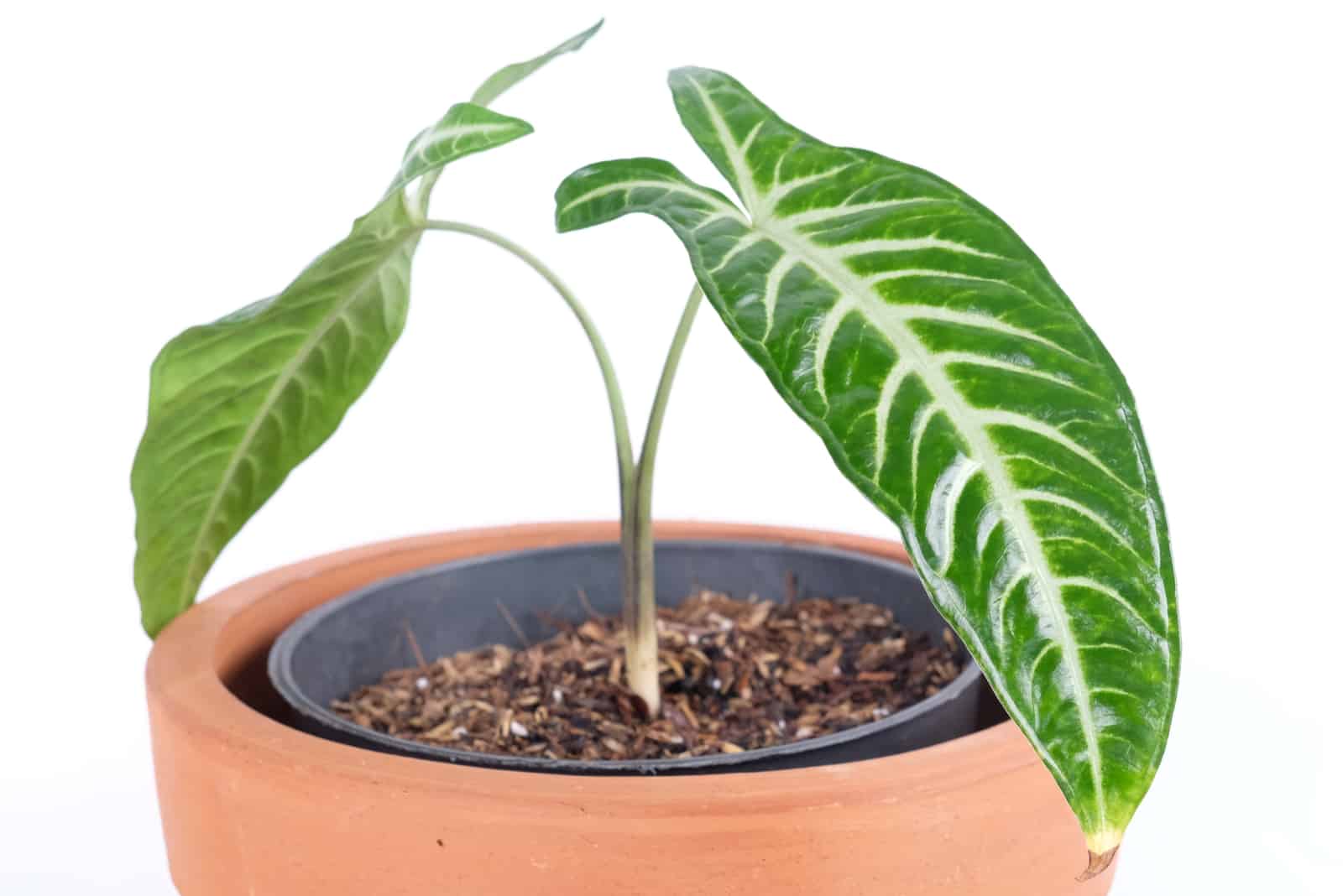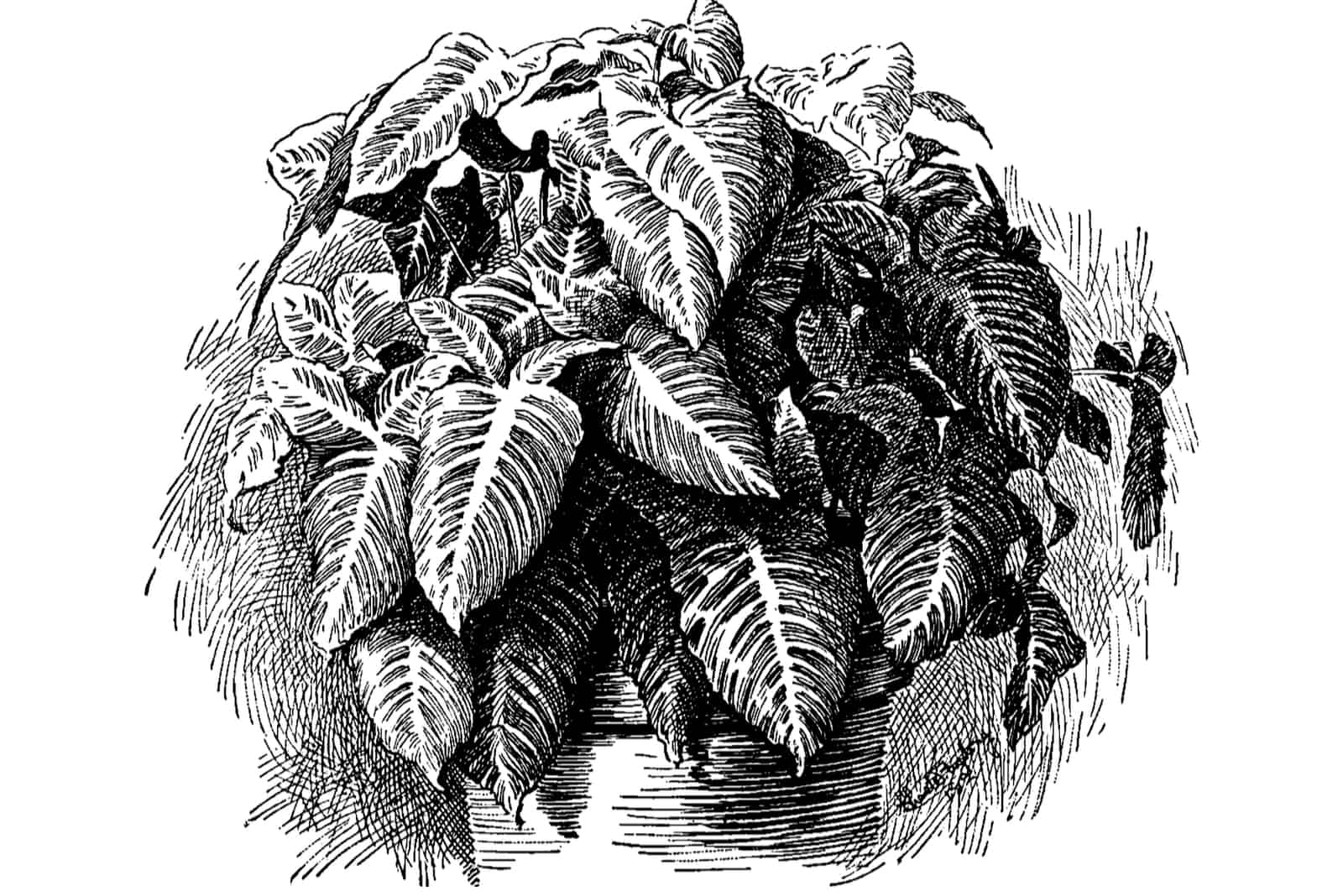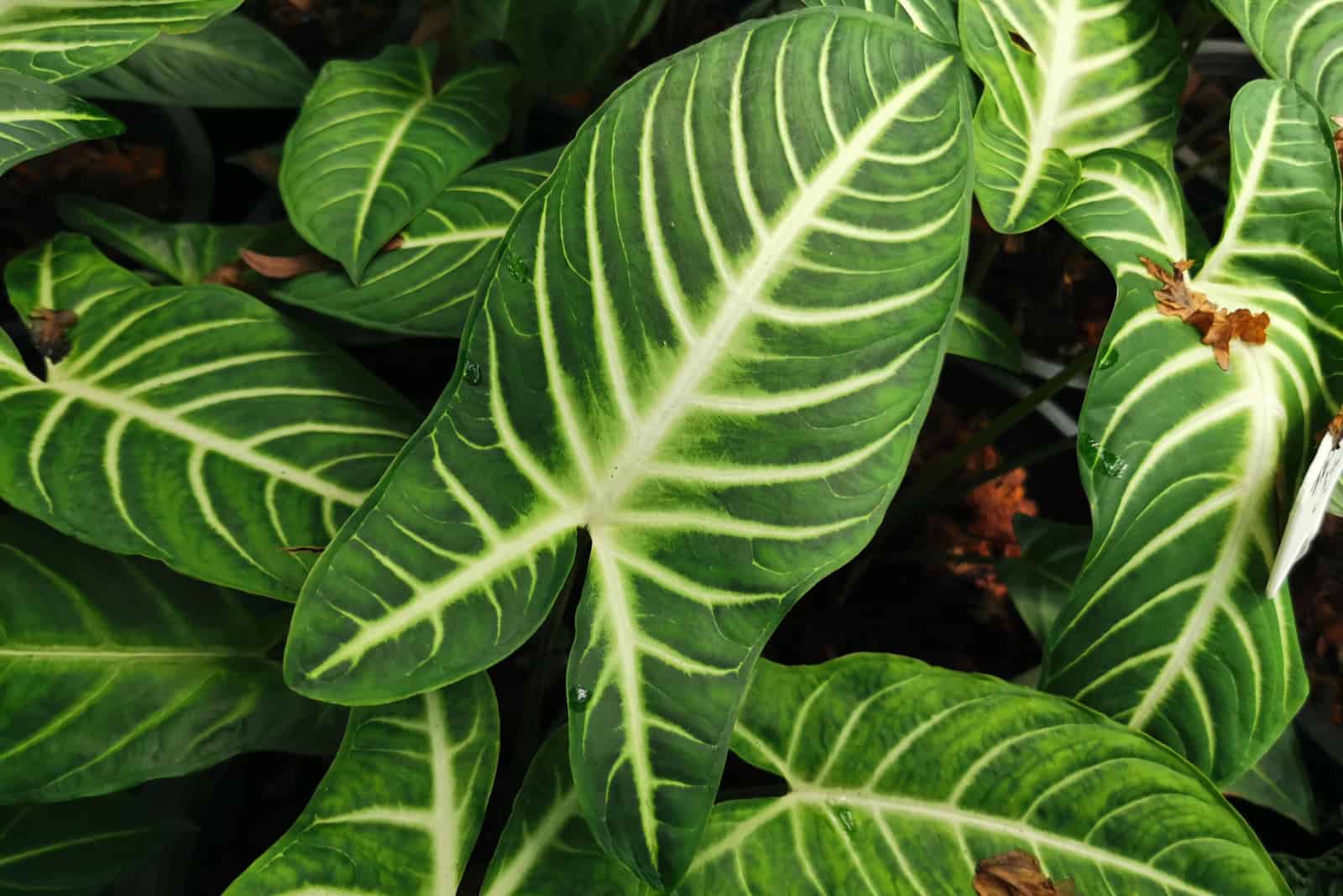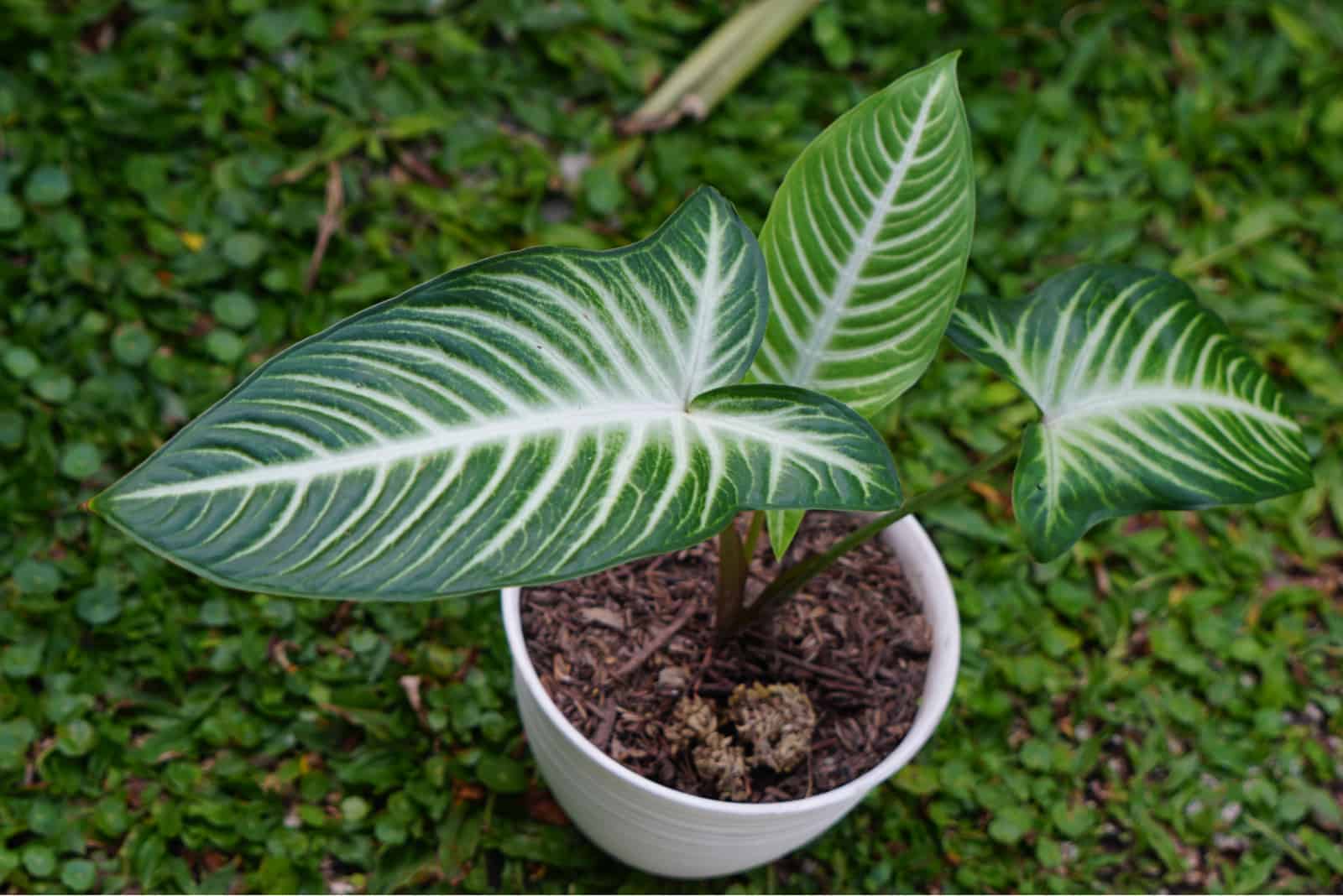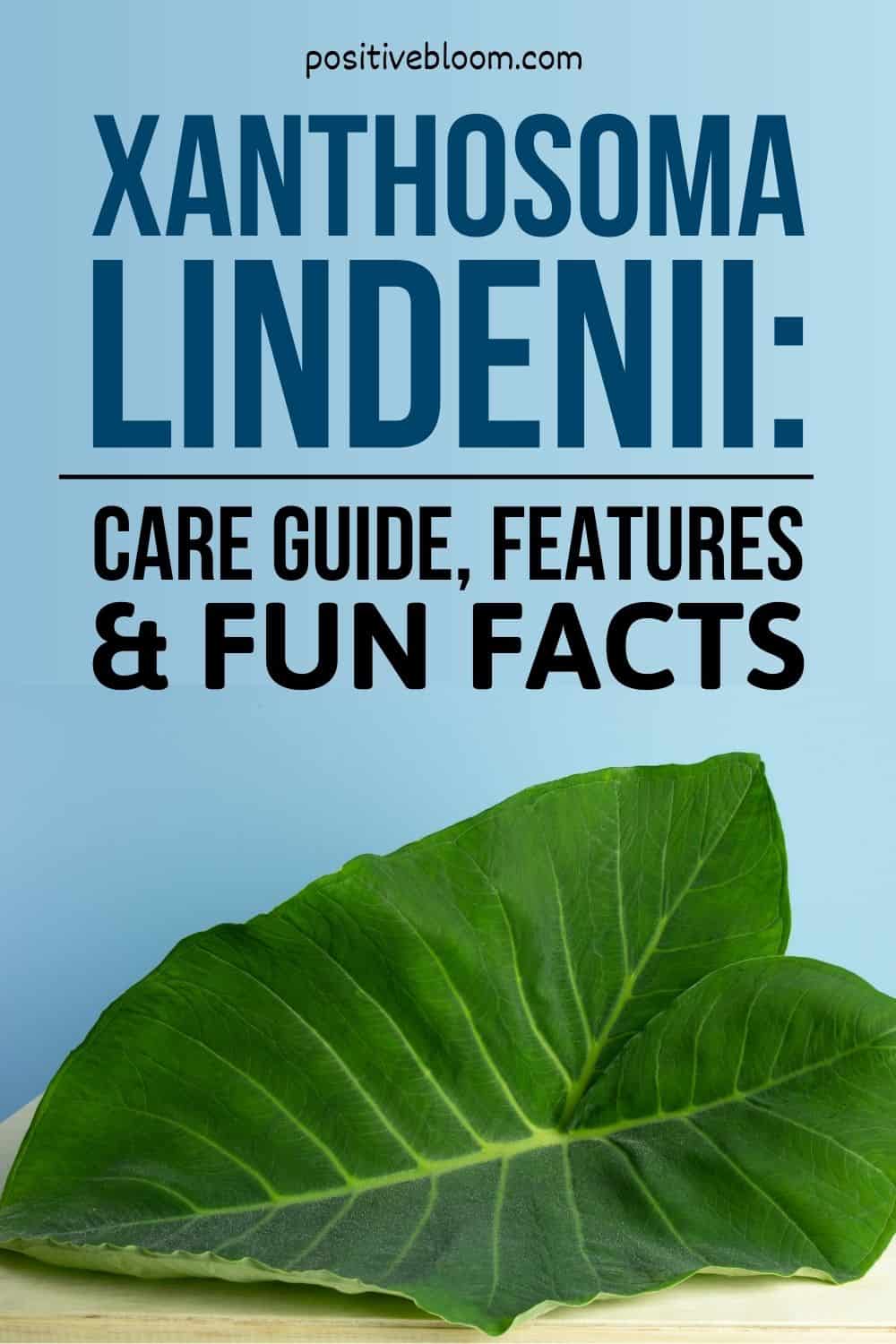If you’re anything like me, you’re always searching for new ways to improve your home. Buying new plants is one of the cheapest and most attractive options. If you’re unsure about what plant to buy, the Xanthosoma lindenii might just be what your home needs!
This unique tropical plant doesn’t require much maintenance, and it can fit anywhere.
Here is the basic information:
[table id=48 /]Even though this plant is toxic if ingested, it still makes for a fantastic houseplant. Simply put it on a flower shelf so your children or pets can’t reach it.
This article will provide you with an extensive care guide for this plant as well as some interesting facts about it.
After reading it, you will be equipped with the knowledge of how to successfully grow a Xanthosoma lindenii, as well as how to deal with pests and diseases if it ever comes to that.
Let’s begin!
Xanthosoma Lindenii Care
The Xanthosoma, or caladium lindenii, has very simple requirements. It needs a bit of sunshine, some water here and there, and well-draining soil to grow into a big and healthy plant, just like your Anthurium radicans.
This section provides a detailed overview of the plant’s basic (and some more advanced) needs.
Follow our care guide, and growing plants will be a piece of cake!
Light
The Xanthosoma lindenii is a perfect indoor plant because of its light requirements.
It needs bright indirect light to reach its full potential. The best place to keep this aroid is on a north or east-facing windowsill. However, if your flat is south-facing or you simply like the way your plant looks on the south or west side of your home, there is no reason you shouldn’t keep it there.
But, keep in mind that direct sunlight can sunburn this plant, so it would be best to keep it some distance away from the windows.
Also, if you’re growing this many-named plant outside, you should keep it in the shade so the midday sun doesn’t scorch its imperial foliage.
In its native habitat, trees protect it from burning, so it would be best to mimic these conditions. However, if you don’t have any trees in your garden or yard, you can always cover them with a shade cloth.
Water And Humidity
This house plant’s water requirements are incredibly modest. But it’s important to keep in mind that the soil shouldn’t be allowed to dry out completely.
The best watering technique is to water the plant when you feel that the topsoil’s first two inches (5cm) are dry. Water the plant thoroughly and allow the excess moisture to drain through the potholes.
Don’t let your plant sit in water for too long as this can lead to root rot and other fungal infections.
You should carefully observe your plant because its looks can tell you a lot about its needs. Healthy plants have leaves that stand upright.However, if you notice that the leaves are drooping, the plant needs more water.
Finally, water your plant less during the winter season, which is when it enters dormancy and is more susceptible to overwatering.
Humidity
The Xanthosoma lindenii is a tropical plant that needs high humidity to thrive. Flats and houses, on average, have low to medium humidity, which means you need to raise it.
Here are our favorite ways of raising humidity levels to match your plant’s needs.
The most common method is misting. You can mist your plant every now and then, but be careful not to overdo it. Let the foliage completely dry before the next misting because excess water on the leaves can lead to fungal diseases.
The second, and probably easier method, is using humidifiers. Simply invest in a quality humidifier, turn it on, and you and your plant can enjoy the rest of the day.
Climate And Temperature
The next part of the plant care checklist is temperature. The Caladium lindenii thrives best in room temperatures, between 65 and 75°F (18-24°C). However, extreme cold, heat, or draft can cause serious health issues to this plant and can even slow down its growth or stop it completely.
If the temperature is lower than 70°F (21°C), this xanthosoma plant will stop producing the tubers in which it stores nutrients and the organic content it needs for growth.
Soil And Fertilizer
This aroid plant loves fertile, slightly acidic soil that is well-draining and provides enough aeration.
If you find yourself at the checkout with caladium, turn around and grab a bag of aroid potting mix. However, if you don’t have this mix at hand, you can make it yourself.
Add vermiculite or perlite to your favorite potting mix to improve the drainage. You can also add orchid bark, coco coir, and horticultural charcoal to improve aeration and eliminate all the impurities.
This plant also loves moisture, so be sure to add sphagnum or peat moss to the mix. The moss retains moisture and releases it when the plant needs it.
Finally, make sure that the soil is rich in nutrients and organic material. You can improve the level of minerals by adding worm castings if you think the soil needs some extra nutrients.
Fertilizer
Only fertilize this houseplant variety during the growing season, which is in spring and summer. In winter, this plant enters dormancy, so if you give it extra food it will not be able to use it.
Use water-soluble liquid fertilizers. Dissolve them in water to at least 50% of their strength before giving them to your plant. This way, you will prevent fertilizer build-up and over-fertilization, which can cause severe damage to this plant’s roots and leaves.
Finally, use all-purpose fertilizer designed for houseplants, such as triple 14 fertilizer, and never apply more than it says on the package.
Fertilizer burn can set your plant’s growth back years!
Pruning And Cleaning
Pruning this tropical plant is not strictly necessary. However, you should cut off any old and dry leaves to make room for new growth.
This plant doesn’t grow too tall, so you don’t have to worry about having to prune it all the time for it to fit in a terrarium or its designated spot.
You can also harvest the foliage with unique patterns for your bouquets and other floral arrangements.
Bear in mind that you should cut the leaves at the soil line, whether you’re simply harvesting the foliage or getting rid of dead or damaged leaves.
Cleaning
Also, you shouldn’t forget to clean your caladium from time to time. If you wipe off the dust with a wet cloth, not only do you clean the foliage, but you’re also raising the humidity for your plant, so it’s a win-win.
Make sure you dry the leaves after wiping the dust, and definitely don’t spray them with water until they’re completely dry, otherwise it can lead to fungal disease. Don’t wipe the leaves with a wet cloth if they didn’t have time to dry properly.
Time Of Repotting
The best time for repotting your caladium is spring because it is the beginning of its growing season. This will give it plenty of time to acclimate to its new pot before the dormancy period.
The Xanthosoma lindenii is a slow-growing plant that doesn’t require frequent repotting, but if you notice roots coming out of the container, increase the pot size. You can do this every year, and if you do, this foliage plant will show you that hard work pays off!
Ensure that the pot has drainage holes and use fresh aroid potting mix or any fertile, well-draining substrate.
You should water your plant thoroughly for 24 hours before repotting so that you can alleviate transplant shock.
After that, you can put it on a shelf in your office or store and just wait for the rave customer reviews you’ll surely get for this wonderful plant!
This variegated plant beautifies everything around it!
Xanthosoma Lindenii Propagation
The Xanthosoma lindenii can be propagated through division, namely by dividing tubers. If you’re new to this method, here’s a short guide on how it’s done.
First, you need to loosen the soil around the plant. You can do this with your bare hands or use a spade. Then simply lift the plant and remove the dirt around the tuber.
Select the tuber you want to replant and gently lift the central bud using a knife. A tuber consists of a central bud and branching buds, and this method allows the smaller buds to produce more stems, leading to a fuller-looking plant.
Let the tubers dry for a few days before you plant them to get the best results.
Here’s how it’s done:
Fun Facts About Caladium Lindenii
Now that you know how to take care of this plant, it’s time to take a look at its history and appearance. This section also discusses the most common issues with Phyllotaenium lindenii, as well as the solutions to those issues.
Origin
This tropical plant is a part of the Araceae family. It has many scientific names, but it’s also known by its more common names ‘Angel Wing’ plant, White Vein Arrow Leaf, Indian Kale, Yautia, and Spoon Flower.
This plant has so many names because botanists regularly renamed it. It’s been called Xanthosoma lindenii, Phyllotaenium lindenii, and Caladium lindenii, but the most common name is Caladium lindenii.
One part of its name never changed, however: lindenii. This plant was named after the Belgian botanist, Jean Jules Linden, who discovered it in the mountain ranges of Colombia.
Even though it has many names, you don’t have to keep up with the recent botanic research and literature. Simply add Xanthosoma lindenii to your wish list, and everyone will know what you’re looking for.
The most famous cultivar of this tropical plant is Xanthosoma lindenii ‘Magnificum’ or Caladium lindenii ‘Magnificum,’ however you prefer to call it.
Finally, caladium, alocasia, and colocasia are all referred to as elephant ears, so be sure not to confuse them. The care guide for elephant ears plants is similar, so if you grow some alocasias or colocasias, you can use the tips I gave you in this article.
Features Of Xanthosoma Lindenii
This perennial plant has impressive green leaves that look like arrowheads streaked with white veins. The color of the leaves can vary between yellowish to deep green.
This plant also produces flowers in summertime, but they are rather unimpressive compared to the foliage. Blooms of this perennial resemble tiny trumpets or calla lily flowers, where white petals surround green spadix.
Common Issues
The Caladium lindenii is a resistant plant, but it still may suffer from issues such as pest infestation and fungal disease.
This section brings you the solutions to the most common issues your ‘Angel Wing’ plant may experience.
Pests
This aroid doesn’t succumb to pest invasion easily, but if mealybugs, aphids, whiteflies, and thrips do appear, here’s what you can do.
First, isolate the plant from the rest so that your other plants don’t get infected.
If the infestation is relatively new and the number of pests isn’t large, you can try and pick them off one by one. You can also use a cotton swab or a Q-tip dipped in alcohol and get rid of them that way.
However, alcohol may cause some damage, so it’s best to stick with insecticidal soaps and neem oil.
Diseases
One of the most common diseases that attack Caladium lindenii is root rot, and the only thing you can do is remove the infected roots, replant the caladium, and reduce the watering.
Most diseases that attack xanthosomas are caused by fungi such as Pythium and Rhizoctonia, which attack the tubers.
You can prevent the development of disease in your new plant by immersing the tubers in water heated to 122°F (50°C) before planting them. Leave the tubers immersed in water for at least half an hour, and then dry them thoroughly.
FAQ
The Xanthosoma lindenii is an exciting plant, and there are more interesting things about it.
In this section, we bring you the answers to the most frequently asked questions about these fair-leaved plants.
Yes and no! The Xanthosoma lindenii only grows naturally in the tropical region of Colombia and some parts of Panama.
However, you can order this plant online for less than $25, which is why this plant is found in many homes around the world.
Caladium and amorphophallus are different genera of the Araceae family.
Caladium is a genus mainly valued for its foliage, and many varieties are grown as houseplants. This genus also contains calcium oxalate and is toxic if ingested.
Amorphophallus is a genus of flowering plants that are not toxic, and some are even edible.
The approximate lifespan of caladiums is one year. These plants are perennials, but they cannot survive the cold, which is why many gardeners grow them as annuals.
However, if you keep them indoors, caladiums can last much longer if you meet their requirements.
Wrapping Up
We have reached the end of this article, and now you have all the basic knowledge required for growing Xanthosoma lindenii!
This article brought you a detailed care guide so that you can make sure your plant has everything it needs. Now you know you shouldn’t keep your caladium in direct light or give it too much water and fertilizer, otherwise its fantastic leaves would start changing color to yellow or brown.
You also know how to deal with those same issues if the need arises, as well as how to propagate xanthosoma to get many more plants that you can give out to your friends and family.
We wish you the best of luck growing this plant.
Until next time!
Like this post? Share or pin it for later!

